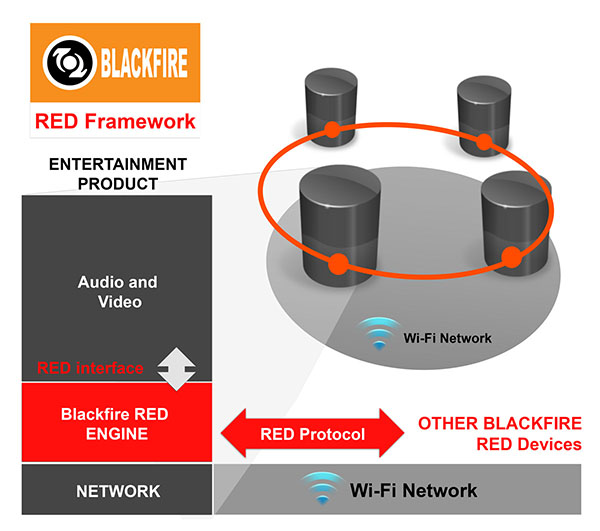Of course, my wifi system can now connect to the wireless speaker. tetris unblocked krunker
Is Your Wi-Fi Network Ready for Wireless Speakers?

But I also began to wonder what role our Wi-Fi network really plays with these new products, and whether the demands are not, in fact, outpacing the capabilities of today’s “average” network. After all, it’s hard to believe manufacturers would release speakers that regularly behave glitchy or drop out in real-world use. Did these things perform this way in their labs? How much can performance really vary from network to network?
So it was with interest that I took a meeting in New York a short while later for a briefing and demo with the principal officers of Blackfire Research. If the name sounds vaguely familiar, it’s because we’ve occasionally mentioned the inclusion of Blackfire’s FireConnect technology in an Onkyo, Integra, or Pioneer product announcement or review; it’s found in some of their AVRs and wireless speakers. Blackfire also powers Harman Kardon’s Omni line of multiroom speakers. But I wasn’t really familiar with the technology or why someone might want it.
Turns out, Blackfire’s founder and CEO Ravi Rajapakse is the former chief technology officer of a major wireless supplier to the Department of Defense, which is another way of saying that he’s been responsible for creating wireless solutions for which cost was little or no object, and in which rock-solid reliability in all sorts of conditions was a primary design goal. His frustration trying to move media files around his own home, and what he saw as the limitations of traditional consumer Wi-Fi, pushed him into the 10 years of research that became Blackfire Red, the current iteration of his firm’s proprietary Wi-Fi protocol.
To provide a basic technical definition here, a protocol in this context is a set of rules that controls how the information packets in a network are transmitted. The Internet uses the TCP/IP protocol (Transmission Control Protocol/Internet Protocol); home networks often use TCP/IP as well, and some media transmissions use RTP (Real-time Transport Protocol), which was designed for streaming audio and video data across IP networks.
All well and good, but as Rajapakse explains it, these protocols were designed in the late 1970s for a wired world. So they make all sorts of assumptions that just don’t apply to today’s wireless networks. For instance, wireless networks are often subject to the momentary collapse of packet delivery because of transient events that occur in radio transmission. But on a TCP/IP network, it’s assumed that any transmission loss on the receiving end is the result of the router being unable to keep up—logical, for a wired network—so the transmitter automatically throttles down the data transmission rate. Oops…
“That’s one of many examples of what’s in those protocols that is inappropriate for the world we live in today,” Rajapakse says. And although manufacturers of wireless products have tried a variety of patches to modernize these archaic systems, “at a certain level of performance, it crashes—it’s building on a foundation that’s not appropriate for what you want to do. These are the sorts of underlying problems we realized and studied, and then decided to try to solve at a foundational level.”
Critically, Blackfire addresses these issues at the software rather than hardware level. Rajapakse says his experience working with the DOD proved that engineering sophisticated antennas or transceivers, for example, can only do so much and would make the technology expensive and unattractive to product manufacturers. So Blackfire’s protocol can be implemented in software at the chip level if a manufacturer has the fiscal scale to achieve that, or can simply be dropped into flash memory and handled by the onboard processor. It is said to require relatively little processing power or memory capacity.

The purpose of all this, Blackfire execs say, is to join up—with reliability and high throughput of data—all of the “entertainment islands” around the house in which our content is currently stranded. Audio or video products enabled for the Blackfire Red protocol (speakers and soundbars, smart TVs, smartphones, laptops, etc.) talk across your existing Wi-Fi network to other Blackfire-enabled products with what is said to be greatly improved data efficiency and stability versus an unadorned network. And as our Wi-Fi networks continue to improve and bandwidth grows, all the better: Blackfire products benefit as well.
I recently had occasion to discuss this reliability issue with an engineer at a speaker company who had recently developed a wireless Wi-Fi speaker, and he described the process of proofing it out in a range of households and environments. Moments when his team thought the system was rock solid became back-to-the-drawing-board learning experiences as it unexpectedly became glitchy on a different network. Perhaps Blackfire, and other companies working in the same space, can help improve our user experience and better protect a manufacturer’s brand integrity by eliminating symptoms that are sure to be blamed on the product rather than the network. We hope to test some Blackfire-enabled products soon.
- Log in or register to post comments


I usually use a wireless speaker connected to bluetooth to use, sometimes I don't need to connect to wifi to still be able to use it. mapquest directions

It really is amazing and helpful to me. Minesweeper

I'm interested to see how Blackfire-capable products function in actual use, and it will be fascinating to observe how they affect the home entertainment market as a whole. This might represent a big advancement in the way we use and enjoy our entertainment systems. 지투지벳

At Velo Snus there are also wireless speakers everywhere. I love these speakers. They have no cables and sound excellent.

Everything is ready. Blackfire's protocol can be implemented in software at the chip level. Therefore tap tap shots are used first.

Great article on preparing your Wi-Fi network for wireless speakers! It's like solving an real iq test for optimal sound experience at home. The detailed tips and insights are incredibly helpful for ensuring a seamless and high-quality audio setup. Really useful for any audiophile looking to upgrade their system!






























































